Let's say I have table like:
first row: 111 | A | 222 | B
second row: 222 | B | 111 | A
And I just would like to keep one of those rows, how to do this?
Let's say I have table like:
first row: 111 | A | 222 | B
second row: 222 | B | 111 | A
And I just would like to keep one of those rows, how to do this?
In Google Sheets, you can add a "helper column" with the formula
=join("|",sort(TRANSPOSE(table_row_reference)))
and then use the Remove Duplicates tool
In Excel O365, you can do the same except the formula would be:
=TEXTJOIN("|",,SORT(table_row_reference,,,TRUE))
Note: table_row_reference is a reference to a single row in the table, eg A1:D1
In earlier versions of Excel (Excel 2010+) you can use Power Query
let
Source = Excel.CurrentWorkbook(){[Name="Table2"]}[Content],
//Change all columns to type Text
typed = Table.TransformColumnTypes(Source,
List.Transform(
Table.ColumnNames(Source),
each {_, type text}
)
),
#"Added Custom" = Table.AddColumn(typed, "Merged", each Text.Combine(List.Sort({[Column1],[Column2],[Column3],[Column4]}),"|")),
#"Removed Duplicates" = Table.Distinct(#"Added Custom", {"Merged"}),
#"Removed Columns" = Table.RemoveColumns(#"Removed Duplicates",{"Merged"})
in
#"Removed Columns"
If you can use a helper column to find duplicates in column B to I from row number 2 then enter the following formula in the row two of the helper column.
=Sort_and_CONCATENATE(B2:I2,"|")
and copy down the formula.
This formula will sort and merge cells in the range "B2:I2". Then you can use remove duplicates on this column.
Following is the user defined function code in VBA
Option Explicit
'============================================================================
Function Sort_and_CONCATENATE(myRng As Range, deLmt As String, Optional srtCriteria = 0)
'srtCriteria is criteria to sort; 0 or nothing for Ascending, Other digit for descending.
Dim myString As String, Lb As Long, Ub As Long, i As Long, j As Long
Dim arr, reverseArray
Dim strTemp As String
arr = myRng.Value
myString = Join(Application.Index(arr, 1, 0), deLmt)
arr = Split(Trim(myString), deLmt)
Lb = LBound(arr)
Ub = UBound(arr)
For i = Lb To Ub - 1
For j = i + 1 To Ub
If IsNumeric(arr(i)) = True And IsNumeric(arr(j)) = True Then
If Val(arr(i)) > Val(arr(j)) Then
strTemp = arr(i)
arr(i) = arr(j)
arr(j) = strTemp
End If
Else
If IsDate(arr(i)) = True And IsDate(arr(j)) = True Then
If DateValue(arr(i)) > DateValue(arr(j)) Then
strTemp = arr(i)
arr(i) = arr(j)
arr(j) = strTemp
End If
Else
If (arr(i)) > (arr(j)) Then
strTemp = arr(i)
arr(i) = arr(j)
arr(j) = strTemp
End If
End If
End If
Next j
Next i
If srtCriteria = 0 Then
Sort_and_CONCATENATE = Join(arr, deLmt)
Else
ReDim reverseArray(Ub)
For i = 0 To Ub
reverseArray(i) = arr(Ub - i)
Next
Sort_and_CONCATENATE = Join(reverseArray, deLmt)
End If
End Function
Also, using this function, we can create following procedure to remove duplicates. Changes in Excel caused by macro cannot be undone. Please try macros on sample/ duplicate data. If we use following procedure, we don't have to use helper column.
Option Explicit
'============================================================================
Sub removeDuplicatesAcrossColumns()
Dim resultArr(), resultColl As New Collection, tblRng As Range, i As Long, j As Long
Set tblRng = Application.InputBox("Select Table Range", "Table Range", , , , , , 8)
For i = 1 To tblRng.Rows.Count
If ExistsInCollection(resultColl, Sort_and_CONCATENATE(tblRng.Rows(i), "|")) = False Then
resultColl.Add i, Sort_and_CONCATENATE(tblRng.Rows(i), "|")
ReDim Preserve resultArr(1 To tblRng.Columns.Count, 1 To resultColl.Count)
For j = 1 To tblRng.Columns.Count
resultArr(j, resultColl.Count) = tblRng(i, j).Formula
Next
End If
Next
tblRng.ClearContents
Range(tblRng(1, 1).Address).Resize(UBound(resultArr, 2), tblRng.Columns.Count).Formula = Application.Transpose(resultArr)
End Sub
'============================================================================
Public Function ExistsInCollection(col As Collection, key As Variant) As Boolean
On Error GoTo err
ExistsInCollection = True
IsObject (col.Item(key))
Exit Function
err:
ExistsInCollection = False
End Function
'============================================================================
In the GIF below, helper column is used to show duplicates. Otherwise, no helper column is required in case of above procedure.
